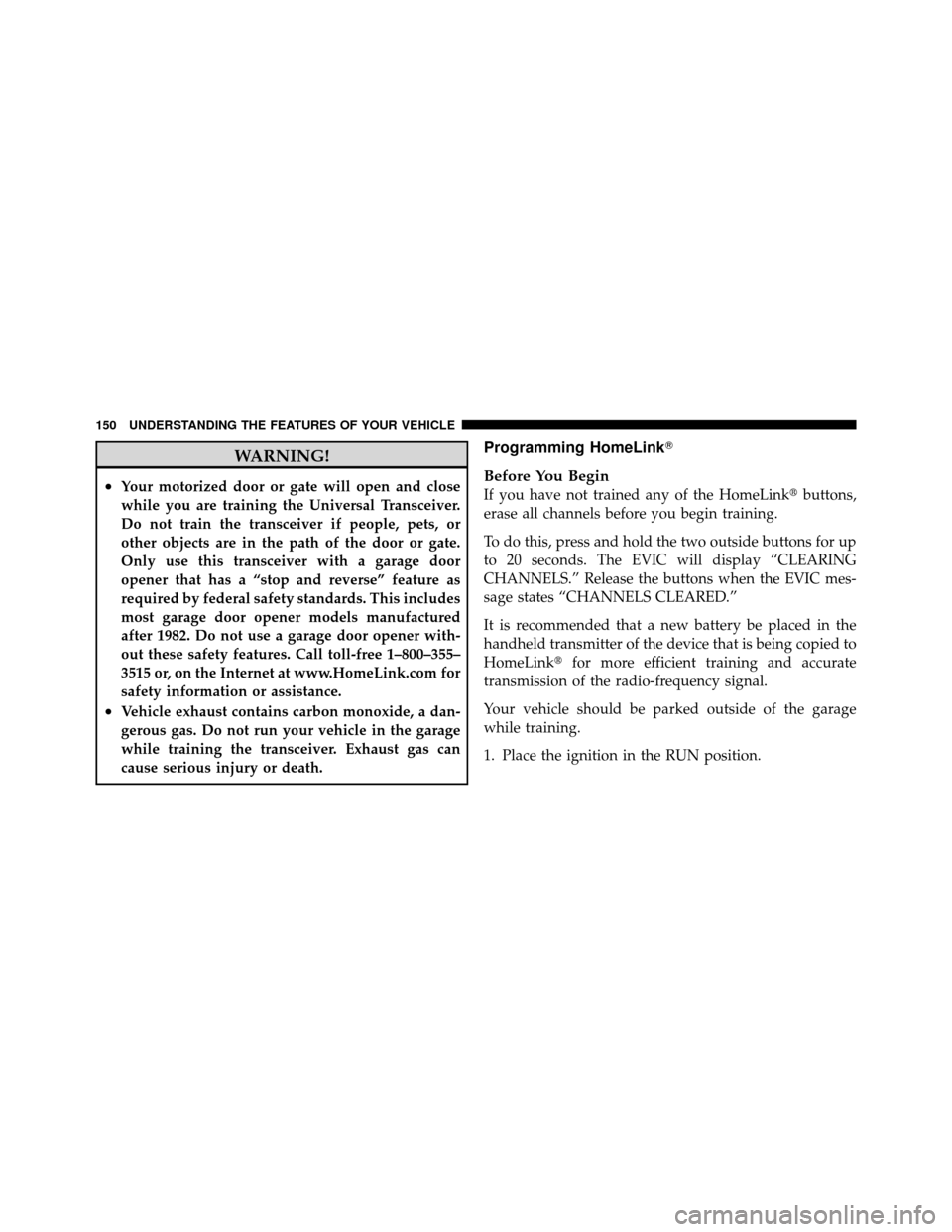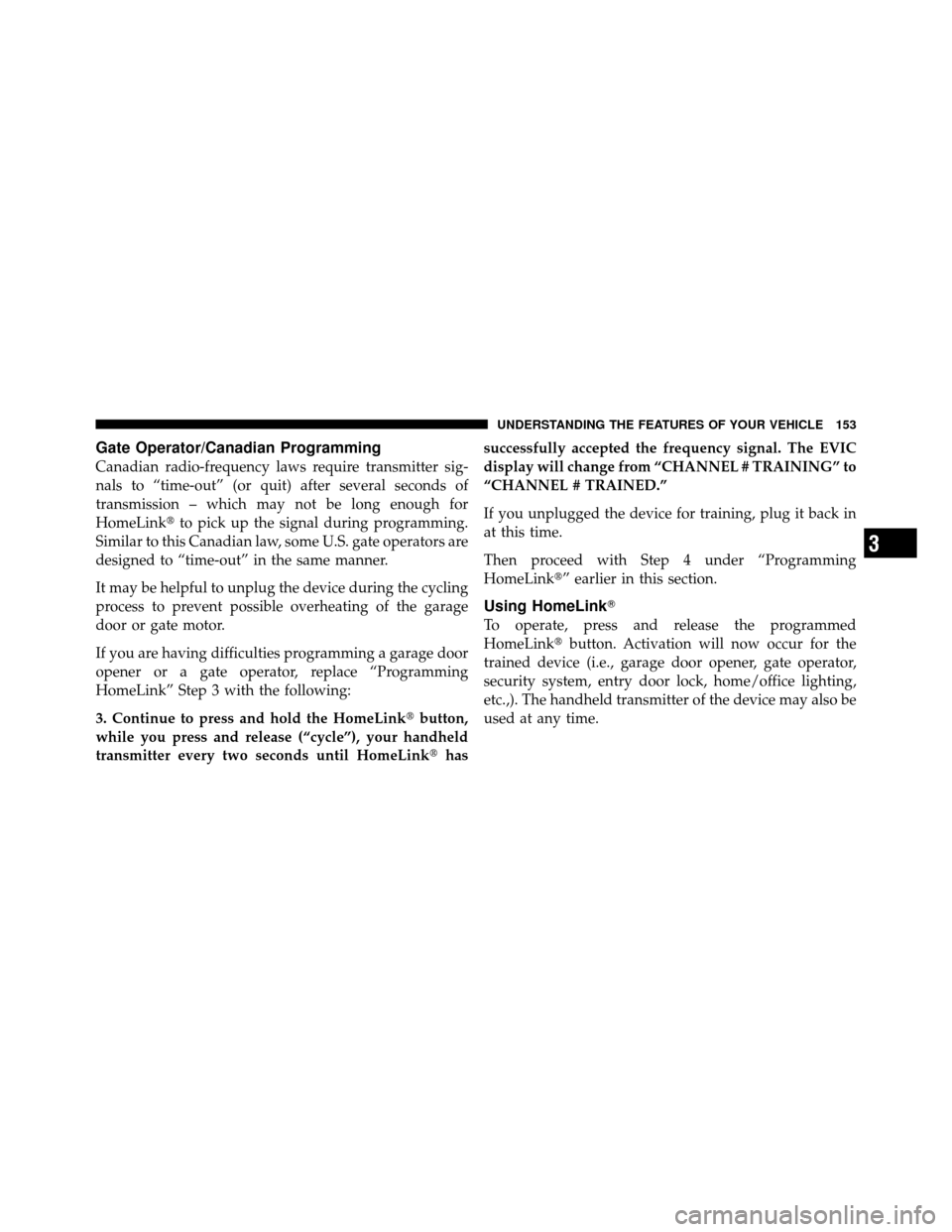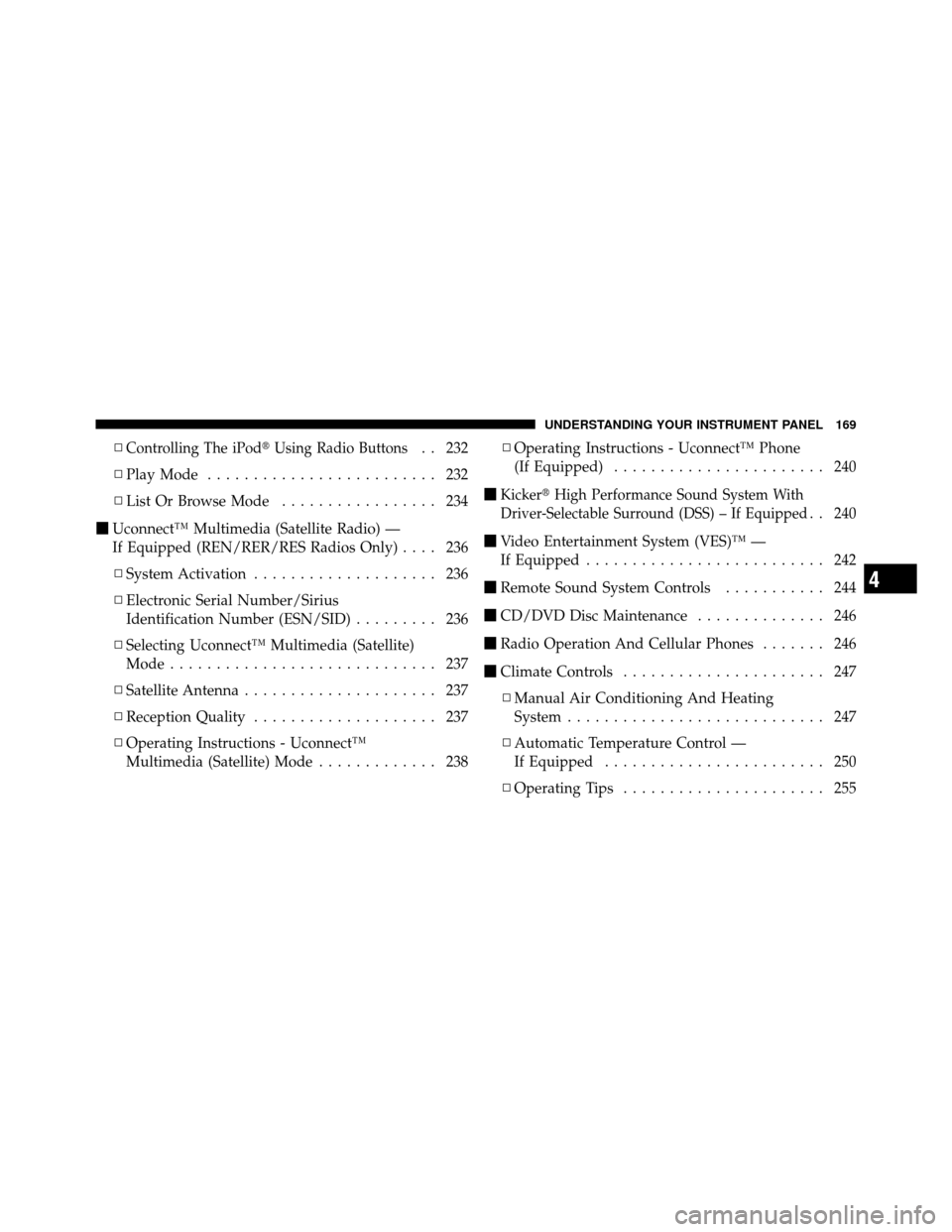Page 151 of 484

WARNING!
•Your motorized door or gate will open and close
while you are training the Universal Transceiver.
Do not train the transceiver if people, pets, or
other objects are in the path of the door or gate.
Only use this transceiver with a garage door
opener that has a “stop and reverse” feature as
required by federal safety standards. This includes
most garage door opener models manufactured
after 1982. Do not use a garage door opener with-
out these safety features. Call toll-free 1–800–355–
3515 or, on the Internet at www.HomeLink.com for
safety information or assistance.
•Vehicle exhaust contains carbon monoxide, a dan-
gerous gas. Do not run your vehicle in the garage
while training the transceiver. Exhaust gas can
cause serious injury or death.
Programming HomeLink�
Before You Begin
If you have not trained any of the HomeLink�buttons,
erase all channels before you begin training.
To do this, press and hold the two outside buttons for up
to 20 seconds. The EVIC will display “CLEARING
CHANNELS.” Release the buttons when the EVIC mes-
sage states “CHANNELS CLEARED.”
It is recommended that a new battery be placed in the
handheld transmitter of the device that is being copied to
HomeLink� for more efficient training and accurate
transmission of the radio-frequency signal.
Your vehicle should be parked outside of the garage
while training.
1. Place the ignition in the RUN position.
150 UNDERSTANDING THE FEATURES OF YOUR VEHICLE
Page 154 of 484

Gate Operator/Canadian Programming
Canadian radio-frequency laws require transmitter sig-
nals to “time-out” (or quit) after several seconds of
transmission – which may not be long enough for
HomeLink�to pick up the signal during programming.
Similar to this Canadian law, some U.S. gate operators are
designed to “time-out” in the same manner.
It may be helpful to unplug the device during the cycling
process to prevent possible overheating of the garage
door or gate motor.
If you are having difficulties programming a garage door
opener or a gate operator, replace “Programming
HomeLink” Step 3 with the following:
3. Continue to press and hold the HomeLink� button,
while you press and release (“cycle”), your handheld
transmitter every two seconds until HomeLink� hassuccessfully accepted the frequency signal. The EVIC
display will change from “CHANNEL # TRAINING” to
“CHANNEL # TRAINED.”
If you unplugged the device for training, plug it back in
at this time.
Then proceed with Step 4 under “Programming
HomeLink�” earlier in this section.
Using HomeLink�
To operate, press and release the programmed
HomeLink�
button. Activation will now occur for the
trained device (i.e., garage door opener, gate operator,
security system, entry door lock, home/office lighting,
etc.,). The handheld transmitter of the device may also be
used at any time.
3
UNDERSTANDING THE FEATURES OF YOUR VEHICLE 153
Page 163 of 484
Rear Seat Cupholders
The rear seat cupholders are located in the center armrest
between the rear seats. The cupholders are positioned
forward in the armrest and side-by-side to provide
convenient access to beverage cans or bottles while
maintaining a resting place for the rear occupants elbows.
STORAGE
Console Features
The center console contains two shift bezel cubby bins
with rubber mats for holding small items. For vehicles
not equipped with navigation radio, the console also
contains an extra storage bin located below the climate
control, which holds up to four CD jewel cases.
Two separate storage compartments are also located
underneath the armrest.
Rear Seat Cupholders
162 UNDERSTANDING THE FEATURES OF YOUR VEHICLE
Page 168 of 484
UNDERSTANDING YOUR INSTRUMENT PANEL
CONTENTS
�Instrument Panel Features ............... 170
� Instrument Cluster – Base ............... 171
� Instrument Cluster – Premium ............ 172
� Instrument Cluster Descriptions ........... 173
� Electronic Vehicle Information Center (EVIC) –
If Equipped .......................... 186
▫ Electronic Vehicle Information Center (EVIC)
Displays ........................... 188
▫ Oil Change Required .................. 189
▫ Trip Functions ...................... 190 ▫
Automatic All Wheel Drive (AWD) Displays
— If Equipped ...................... 193
▫ Driver-Selectable Surround Sound (DSS) –
If Equipped ........................ 194
▫ Compass Display .................... 195
▫ Navigation — If Equipped .............. 197
▫ Personal Settings (Customer-Programmable
Features) .......................... 197
� Media Center 730N/430 (RER/REN/RBZ) —
AM/FM Stereo Radio And CD/DVD/HDD/
NAV — If Equipped .................... 201
4
Page 169 of 484

▫Operating Instructions — Voice Command
System (VR) — If Equipped ............. 202
▫ Operating Instructions — Uconnect™ Phone
— If Equipped ...................... 202
▫ Clock Setting Procedure — RBZ Radio ..... 202
▫ Clock Setting Procedure —
RER/REN Radio ..................... 203
� Media Center 130 (RES) — AM/FM Stereo
Radio With CD Player (MP3 AUX Jack) ....... 206
▫ Operating Instructions — Radio Mode ..... 206
▫ Operation Instructions — CD Mode For CD
And MP3 Audio Play ................. 209
▫ Notes On Playing MP3 Files ............ 211
▫ Operation Instructions - Auxiliary Mode .... 214�
Media Center 130 (RES/RSC) — AM/FM
Stereo Radio With CD Player (MP3 AUX Jack)
And Sirius Radio ...................... 214
▫ Operating Instructions — Radio Mode ..... 215
▫ Operation Instructions — CD Mode For CD
And MP3 Audio Play ................. 220
▫ Notes On Playing MP3 Files ............ 222
▫ List Button (CD Mode For MP3 Play) ...... 225
▫ Info Button (CD Mode For MP3 Play) ...... 225
▫ Uconnect™ Multimedia (Satellite Radio) —
If Equipped ........................ 226
� Universal Consumer Interface (UCI) 0.5 —
If Equipped .......................... 230
▫ Connecting The iPod� ................. 231
▫ Using This Feature ................... 232
168 UNDERSTANDING YOUR INSTRUMENT PANEL
Page 170 of 484

▫Controlling The iPod�Using Radio Buttons. . 232
▫ Play Mode ......................... 232
▫ List Or Browse Mode ................. 234
� Uconnect™ Multimedia (Satellite Radio) —
If Equipped (REN/RER/RES Radios Only) .... 236
▫ System Activation .................... 236
▫ Electronic Serial Number/Sirius
Identification Number (ESN/SID) ......... 236
▫ Selecting Uconnect™ Multimedia (Satellite)
Mode ............................. 237
▫ Satellite Antenna ..................... 237
▫ Reception Quality .................... 237
▫ Operating Instructions - Uconnect™
Multimedia (Satellite) Mode ............. 238▫
Operating Instructions - Uconnect™ Phone
(If Equipped) ....................... 240
�
Kicker� High Performance Sound System With
Driver-Selectable Surround (DSS) – If Equipped
. . 240
� Video Entertainment System (VES)™ —
If Equipped .......................... 242
� Remote Sound System Controls ........... 244
� CD/DVD Disc Maintenance .............. 246
� Radio Operation And Cellular Phones ....... 246
� Climate Controls ...................... 247
▫ Manual Air Conditioning And Heating
System ............................ 247
▫ Automatic Temperature Control —
If Equipped ........................ 250
▫ Operating Tips ...................... 255
4
UNDERSTANDING YOUR INSTRUMENT PANEL 169
Page 171 of 484
INSTRUMENT PANEL FEATURES
1 — Air Outlet7 — Climate Control13 — Hood Release
2 — Instrument Cluster 8 — Heated Seat Switch*14 — Trunk Release Button
3 — Hazard Switch 9 — Power Outlet15 — Headlight Switch
4 — Electronic Stability Program OFF Button* /
Traction Control System OFF Button* 10 — Ash Tray*
* If Equipped
5 — Glove Compartment 11 — Storage Compartment*
6 — Radio 12 — Ignition Switch
170 UNDERSTANDING YOUR INSTRUMENT PANEL
Page 175 of 484

6. Charging System Warning LightThis light shows the status of the electrical charg-
ing system. The light should turn on when the
ignition switch is first turned ON and remain on briefly
as a bulb check. If the light stays on or turns on while
driving, turn off some of the vehicle’s non-essential
electrical devices (i.e., radio) or slightly increase engine
speed (if at idle). If the light remains on, it means that the
charging system is experiencing a problem. See your
local authorized dealer to obtain service immediately.
If jump starting is required, refer to “Jump Starting
Procedures” in “What To Do In Emergencies”.
7. Electronic Throttle Control (ETC) Warning Light This light will turn on briefly as a bulb check
when the ignition switch is turned ON. This
light will also turn on while the engine is
running if there is a problem with the Elec-
tronic Throttle Control (ETC) system. If the light comes on while the engine is running, safely
bring the vehicle to a complete stop as soon as possible,
place the shift lever in PARK, and cycle the ignition key.
The light should turn off. If the light remains lit with the
engine running, your vehicle will usually be drivable.
However, see an authorized dealer for service as soon as
possible.
If the light is flashing when the engine is running,
immediate service is required. In this case, you may
experience reduced performance, an elevated/rough idle
or engine stall, and your vehicle may require towing.
Also, have the system checked by an authorized dealer if
the light does not come on during starting.
8. Temperature Gauge
The temperature gauge shows engine coolant tempera-
ture. Any reading within the normal range indicates that
the engine cooling system is operating satisfactorily.
174 UNDERSTANDING YOUR INSTRUMENT PANEL